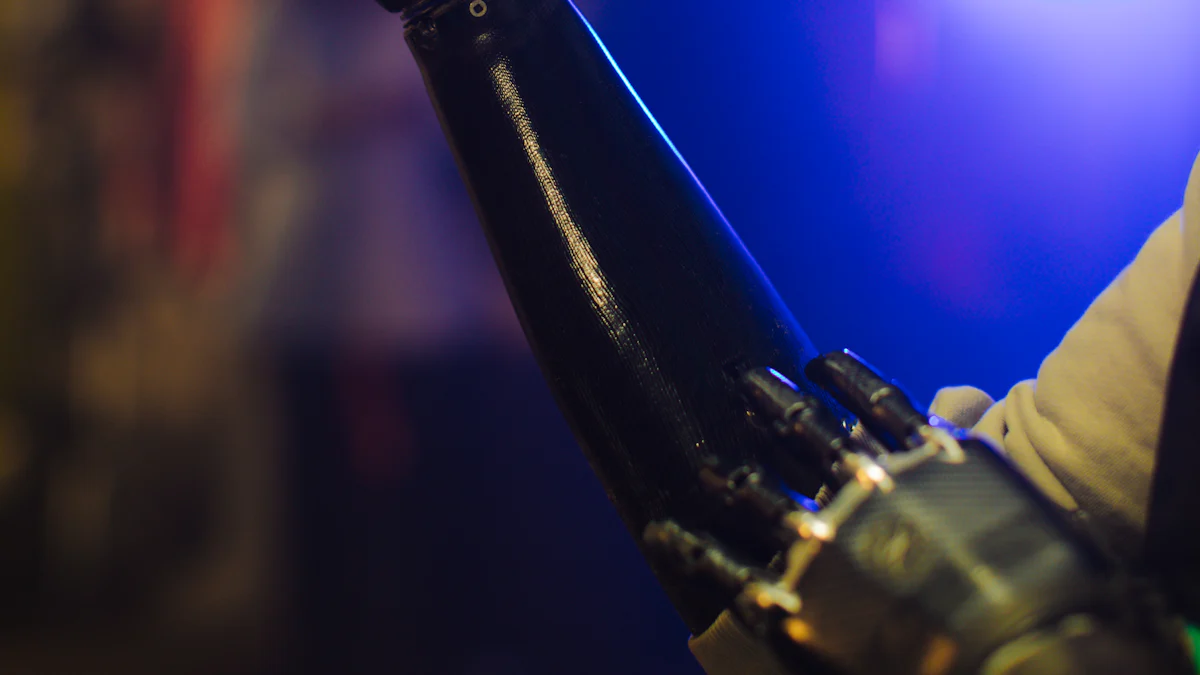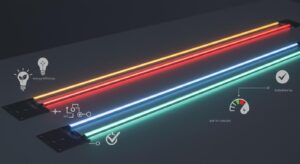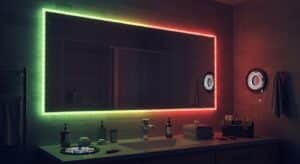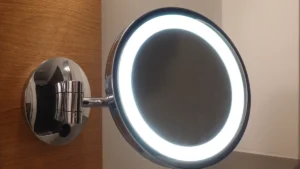
In the world of robotics, LED strip lights play a crucial role in enhancing interaction between humanoid robots and humans. These lights provide non-verbal communication cues, making it easier for you to understand the robot’s intentions. For instance, when a robot is ready to receive commands or has completed a task, the lights can signal these states effectively. Additionally, LED strip lights serve as decorative elements, adding aesthetic appeal while indicating the robot’s status or activity. This dynamic visual feedback not only improves communication but also enriches the overall experience with humanoid robots.
Key Takeaways
LED strip lights enhance communication by providing non-verbal cues, making it easier for users to understand a robot’s intentions.
Choosing the right type of LED strip—flexible for creative designs or rigid for stability—can significantly impact the robot’s functionality and aesthetics.
RGB LED strips offer dynamic color options that can convey emotions or statuses, while single color strips provide consistent lighting.
Proper installation involves careful planning of layout, securing the strips effectively, and ensuring correct wiring to avoid connectivity issues.
Energy-efficient LED technology extends battery life, allowing humanoid robots to operate longer without frequent recharging.
Integrating LED lights with sensors and cameras enhances a robot’s interaction capabilities, allowing it to respond to environmental changes.
Future advancements in LED technology and AI integration promise to revolutionize the functionality and applications of humanoid robots.
Types of LED Strip Lights Suitable for Humanoid Robots

When choosing LED strip lights for humanoid robots, you must consider several factors to ensure optimal performance and compatibility. Different types of LED strips offer unique benefits, making them suitable for various applications in robotics.
Flexible vs. Rigid LED Strips
Flexible LED strips provide versatility in installation. You can bend and shape them to fit the contours of a robot’s body, allowing for creative placement and design. These strips are ideal for areas that require a snug fit or where the robot’s surface is not flat. On the other hand, rigid LED strips offer durability and stability. They are perfect for straight surfaces or areas where you need a more permanent lighting solution. Both types of strips use diodes to emit light, but their structural differences make them suitable for different parts of a humanoid robot.
RGB vs. Single Color LEDs
RGB LED strips are popular in robotics due to their ability to display a wide range of colors. By combining red, green, and blue diodes, these strips can produce millions of color variations. This feature allows you to program dynamic light patterns, enhancing the robot’s ability to communicate non-verbally. For example, you can use RGB LED strips to indicate different emotions or statuses by changing colors. Single color LED strips, however, focus on one specific hue. They are useful when you need consistent lighting without the need for color changes. Both RGB and single color strips rely on diodes to function, but RGB strips offer more flexibility in terms of visual expression.
Waterproof and Durable Options
In environments where moisture or dust is a concern, waterproof LED strip lights become essential. These strips come with a protective casing that shields the diodes from water and steam, ensuring longevity and reliability. Whether you install them outdoors or in areas prone to spills, waterproof options provide peace of mind. Durability is another critical factor. High-quality LED strips, such as those in the Industrial Series, boast robust construction and long lifespans. They can withstand the rigors of continuous use, making them suitable for demanding robotic applications. By choosing waterproof and durable LED strips, you ensure that the diodes remain protected and functional over time.
How to Install LED Strip Lights in Robots
Installing LED strip lights in humanoid robots involves several steps to ensure proper functionality and aesthetic appeal. Whether you’re a hobbyist or a professional, understanding the process can help you achieve the best results.
Planning the Layout
Before you begin the installation, planning the layout is crucial. You need to decide where the LED strip lights will be placed on the robot. Consider areas that will enhance communication and aesthetics. For example, placing lights around the eyes or along the arms can highlight movements and expressions. Sketch a diagram of the robot and mark the intended locations for the lights. This step helps you visualize the final look and ensures that you have enough materials for the project.
Securing the Strips
Once you have a plan, the next step is securing the strips to the robot’s surface. Most LED strip lights come with adhesive backing, making it easy to attach them to various surfaces. Clean the area thoroughly to ensure the adhesive sticks properly. If the surface is uneven or the adhesive is not strong enough, consider using additional fasteners like clips or brackets. These provide extra support and prevent the strips from peeling off over time. Properly securing the strips is essential for maintaining the integrity of the installation.
Wiring and Connectivity
The final step in the installation process involves wiring and connectivity. Begin by connecting the LED strip lights to a power source. Ensure that the voltage and current match the specifications of the strips to avoid damage. Use connectors to join multiple strips if needed, and make sure all connections are secure. Testing the lights before finalizing the installation is important. This step allows you to check for any connectivity issues and make adjustments as necessary. If you’re not familiar with electrical work, consulting an electrician can be beneficial to ensure safety and efficiency.
By following these steps, you can successfully install LED strip lights in humanoid robots, enhancing their functionality and appearance.
Power Requirements and Management
Understanding the power requirements and management of LED strip lights in humanoid robots is crucial. Proper power management ensures that the LEDs function efficiently and safely, enhancing the robot’s performance and longevity.
Voltage and Current Considerations
When installing LED strip lights, you must consider the voltage and current specifications. Most LED strips operate on low voltage, typically 12V or 24V. You need to match the power supply to the LED strip’s voltage to prevent damage. Using a power supply with the correct voltage ensures that the LEDs illuminate properly without flickering or dimming. Additionally, consider the current draw of the LED strips. Calculate the total current required by adding up the current draw of each strip. This helps you choose a power supply that can handle the load, ensuring consistent performance.
Battery Life and Efficiency
Battery life is a significant factor when using LED strip lights in humanoid robots. Efficient power management extends the battery life, allowing the robot to operate longer between charges. Choose LED strips with high energy efficiency to minimize power consumption. Look for LEDs with a high lumen-to-watt ratio, which indicates better efficiency. Implementing power-saving features, such as dimming or turning off the LEDs when not needed, can also conserve battery life. By optimizing the power usage, you ensure that the robot remains functional for extended periods.
Safety Precautions
Safety is paramount when dealing with electrical components like LED strip lights. Ensure that all connections are secure and insulated to prevent short circuits. Use appropriate fuses or circuit breakers to protect the system from overloads. Avoid overloading the power supply, as this can cause overheating and potential damage. Regularly inspect the wiring and connections for signs of wear or damage. By following these safety precautions, you protect both the LED strips and the humanoid robot from electrical hazards.
Integration with Robot Systems
Integrating LED strip lights into humanoid robots requires careful planning and execution. This integration enhances the robot’s functionality and interaction capabilities, making it more engaging and effective in various applications.
Synchronization with Movement
To achieve seamless interaction, you must synchronize LED lights with the robot’s movements. This synchronization allows the lights to change in real-time, reflecting the robot’s actions and intentions. For example, when the robot waves its hand, the lights can illuminate in a wave pattern, enhancing the visual effect. Real-time control is essential here, as it ensures that the lights respond instantly to the robot’s movements. By using sensors and actuators, you can create a system where the LED lights and the robot’s movements are perfectly aligned, providing a more immersive experience.
Programming Light Patterns
Programming light patterns is a crucial aspect of integrating LED strip lights into robot systems. You have the flexibility to design various lighting effects that can convey different messages or emotions. For instance, you can program the lights to flash red when the robot encounters an error or to glow green when it completes a task successfully. This level of control allows you to customize the robot’s appearance and behavior, making it more interactive and communicative. By using advanced lighting control software, you can create complex patterns and animations that enhance the robot’s visual appeal and functionality.
Compatibility with Sensors and Cameras
Ensuring compatibility with sensors and cameras is vital when integrating LED strip lights into humanoid robots. Sensors can detect environmental changes and trigger specific lighting effects, while cameras can capture these effects for analysis or display. For example, if a sensor detects a person approaching, the lights can change color to indicate the robot’s awareness. This integration enhances the robot’s ability to interact with its surroundings and provides valuable feedback to users. By ensuring that the LED lights work harmoniously with other components, you create a cohesive system that maximizes the robot’s capabilities.
“Ready-to-install smart LED strips have convenient plug-and-play operation, while programming introduces far more flexibility by allowing granular control over multi-color effects, lighting animations, and system integration capabilities.”
By integrating LED strip lights with robot systems, you enhance the robot’s interactive visual effects and overall performance. This integration not only improves communication but also enriches the user’s experience with humanoid robots.
Benefits of Using LED Strip Lights in Humanoid Robots

LED strip lights offer several advantages when integrated into humanoid robots. These benefits enhance the robot’s functionality and interaction with users, making them an essential component in modern robotics.
Enhanced Communication and Interaction
LED strip lights significantly improve communication between humanoid robots and humans. By providing non-verbal cues, these lights help you understand the robot’s intentions and actions. For instance, a robot can use a combination of flashing lights and sound to prompt you to perform a specific task. This multi-modal approach makes instructions clear and easy to follow. The visual feedback from the lights ensures that you receive immediate and understandable signals, enhancing your interaction with the robot.
Improved Aesthetic Appeal
The aesthetic appeal of humanoid robots is greatly enhanced by the use of LED strip lights. These lights add a dynamic visual element that makes robots more engaging and attractive. You can customize the colors and patterns of the lights to suit different environments or purposes. Whether it’s a soft glow for a calming effect or vibrant colors for a lively atmosphere, LED lights transform the robot’s appearance. This visual feedback not only makes the robot more appealing but also helps convey its status or emotions effectively.
Energy Efficiency
LED technology is known for its energy efficiency, making it an ideal choice for humanoid robots. LED strip lights consume less power compared to traditional lighting options, which extends the robot’s battery life. This efficiency allows the robot to operate longer without frequent recharging. Additionally, LEDs produce minimal heat, reducing the risk of overheating and ensuring safe operation. By choosing energy-efficient LED lights, you contribute to sustainable practices in robotics while enjoying the benefits of prolonged usage and reduced energy costs.
Challenges and Troubleshooting
When working with LED strip lights in humanoid robots, you might encounter several challenges. Understanding these issues and knowing how to troubleshoot them can ensure a smooth installation and long-lasting performance.
Common Installation Issues
During the installation of LED strip lights, you may face some common issues. One frequent problem is improper adhesion. If the surface isn’t clean or smooth, the adhesive backing might not stick well. To fix this, clean the surface thoroughly before applying the strips. Another issue is incorrect placement. Planning the layout beforehand helps avoid this. Sketch a diagram of the robot and mark where you want the lights. This ensures you have enough materials and that the lights are placed effectively.
Troubleshooting Connectivity Problems
Connectivity problems can arise when installing LED strip lights. If the lights don’t turn on, check the power source first. Ensure the voltage matches the LED strip’s requirements. For remote-controlled LED strips, make sure the receiver is properly connected between the LED tape and the driver. This setup allows you to change colors using a remote or phone app. If you’re using RGB LED strips, ensure the wires are connected correctly. Use an RGB connector if you don’t have a soldering iron. This ensures the black wire goes to the ‘+’ icon, blue to ‘B’, green to ‘G’, and red to ‘R’.
Maintenance and Longevity
Maintaining LED strip lights is crucial for their longevity. Regularly inspect the strips for any signs of wear or damage. Check the wiring and connections to ensure they remain secure. If you notice any flickering or dimming, it might indicate a power issue. Ensure the power supply is adequate and that the connections are tight. By taking these steps, you can extend the life of your LED strip lights and keep your humanoid robot functioning optimally.
Future Trends and Innovations
As technology evolves, LED strip lights continue to advance, offering exciting possibilities for humanoid robots. These innovations promise to enhance the capabilities and applications of robotics, making them more versatile and effective.
Advances in LED Technology
LED technology has seen significant improvements, making it more efficient and versatile. You can now find LEDs that offer brighter illumination with less energy consumption. This efficiency is crucial for robots, as it extends battery life and reduces the need for frequent recharging. Additionally, new LED designs allow for more flexible and compact installations, enabling you to integrate them into various parts of a robot’s body. These advancements make LEDs an ideal choice for enhancing the visual appeal and functionality of humanoid robots.
Integration with AI and Machine Learning
The integration of LED strip lights with artificial intelligence (AI) and machine learning opens up new possibilities for robotics. By using AI, you can program LEDs to respond intelligently to different situations. For example, a robot can change its LED colors based on the emotions it detects from a human’s facial expressions. Machine learning algorithms can help the robot learn from interactions, improving its responses over time. This integration makes robots more intuitive and capable of providing personalized experiences.
Potential for New Applications
The potential applications of LED strip lights in robotics are vast and varied. In healthcare, robots equipped with LEDs can assist in patient monitoring by changing colors to indicate vital signs. In education, robots can use LEDs to engage students with interactive lessons. The entertainment industry can benefit from robots with dynamic LED displays, creating captivating performances. As LED technology continues to evolve, you can expect to see even more innovative applications that enhance the capabilities of humanoid robots.
LED strip lights play a vital role in humanoid robots, offering enhanced communication and aesthetic appeal. These lights provide bright, comfortable illumination, aiding in tasks and reducing errors. You benefit from their energy efficiency, which extends the robot’s operational time. However, challenges like installation issues and connectivity problems require attention. Looking ahead, advancements in LED technology promise even greater energy efficiency and improved lighting quality. These innovations hold the potential to revolutionize robotics, making robots more versatile and effective in various applications.
FAQ
What are LED strip lights used for in humanoid robots?
LED strip lights in humanoid robots serve multiple purposes. They enhance non-verbal communication, making it easier for you to understand the robot’s intentions. These lights also add aesthetic appeal and indicate the robot’s status or activity. By using LED strip lights, robots can provide dynamic visual feedback, which is crucial for expressing emotions or intentions.
How do you choose the best LED strip light for your project?
When selecting LED strip lights for your project, consider factors like flexibility, color options, and durability. Flexible strips allow for creative placement, while RGB strips offer a wide range of colors for dynamic patterns. If your project involves exposure to moisture or dust, opt for waterproof and durable options to ensure longevity.
Are LED strip lights safe to use in robots?
Yes, LED strip lights are generally safe to use in robots. However, you must follow safety precautions during installation. Ensure all connections are secure and insulated to prevent short circuits. Use appropriate fuses or circuit breakers to protect the system from overloads. Regularly inspect the wiring and connections for signs of wear or damage.
How do LED strip lights enhance communication in humanoid robots?
LED strip lights enhance communication by providing non-verbal cues. For instance, a robot can use different colors to indicate various states or emotions. This visual feedback helps you understand the robot’s actions and intentions more clearly, improving interaction and engagement.
What are the power requirements for LED strip lights in robots?
Most LED strip lights operate on low voltage, typically 12V or 24V. You need to match the power supply to the LED strip’s voltage to prevent damage. Consider the current draw of the LED strips and choose a power supply that can handle the load. Efficient power management extends battery life and ensures consistent performance.
Can LED strip lights be integrated with sensors and cameras in robots?
Yes, LED strip lights can be integrated with sensors and cameras in robots. Sensors can trigger specific lighting effects based on environmental changes, while cameras can capture these effects for analysis or display. This integration enhances the robot’s ability to interact with its surroundings and provides valuable feedback to users.
What are the benefits of using LED strip lights in humanoid robots?
LED strip lights offer several benefits, including enhanced communication, improved aesthetic appeal, and energy efficiency. They provide non-verbal cues that help you understand the robot’s intentions. The lights also add a dynamic visual element, making robots more engaging and attractive. Additionally, LED technology consumes less power, extending the robot’s operational time.
What challenges might you face when installing LED strip lights in robots?
Common challenges include improper adhesion, incorrect placement, and connectivity problems. To address these issues, clean the surface thoroughly before applying the strips and plan the layout beforehand. Ensure the power source matches the LED strip’s requirements and check all connections for security.
How do advances in LED technology impact humanoid robots?
Advances in LED technology make LEDs more efficient and versatile. New designs offer brighter illumination with less energy consumption, extending battery life. Flexible and compact installations enable integration into various parts of a robot’s body. These advancements enhance the visual appeal and functionality of humanoid robots.
What future trends can you expect in the use of LED strip lights in robotics?
Future trends include integration with AI and machine learning, allowing robots to respond intelligently to different situations. Potential applications span healthcare, education, and entertainment, where robots equipped with LEDs can engage users with interactive experiences. As LED technology evolves, expect more innovative applications that enhance the capabilities of humanoid robots.
See Also
Choosing The Perfect LED Strip Lights For Linear Lighting
A Comparison Between Flexible And Rigid LED Strips
Effective Installation Tips For RGB LED Strip Lights



